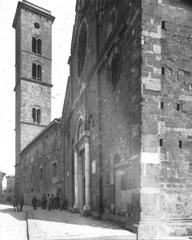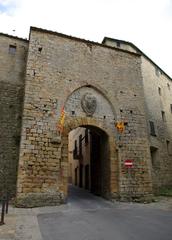Fonte di Docciola Visiting Hours, Tickets, and Travel Guide – Volterra Historical Sites
Date: 14/06/2025
Introduction: The Fonte di Docciola – History and Significance
At the foot of Volterra’s storied historic center lies the remarkable Fonte di Docciola—a monument that has borne witness to centuries of Tuscan history, culture, and daily life. With origins tracing back to Etruscan civilization, this ancient spring was vital for sustaining Volterra’s population, agriculture, and ritual practices, as shown by archaeological finds such as votive statuettes (Borghi di Toscana). Over the centuries, Fonte di Docciola evolved to meet the needs of the city, becoming a linchpin of Volterra’s urban infrastructure during the Middle Ages. Its Gothic architecture, integration with the Porta di Docciola gate, and its role in communal and industrial activities—especially in the wool trade—highlight the ingenuity of medieval hydraulic engineering (ItalyGuides.it).
Today, Fonte di Docciola remains freely accessible year-round. Visitors can experience its blend of natural beauty and historical resonance—climbing its 251-step staircase rewards you with stunning views and proximity to Volterra’s renowned landmarks, such as the Etruscan Acropolis and Museo Etrusco Guarnacci (Toscana Oggi). Whether you’re a fan of ancient history, medieval architecture, or authentic Tuscan experiences, Fonte di Docciola offers a captivating glimpse into Volterra’s layered past.
Contents Overview
- Introduction and Historical Significance
- Etruscan Origins and Early Importance
- Medieval Transformation and Urban Integration
- Architectural Features and Modifications
- Visitor Information: Hours, Tickets, Accessibility
- Socio-Economic and Cultural Impact
- Conservation and Modern Relevance
- Nearby Attractions and Travel Tips
- Frequently Asked Questions (FAQ)
- Conclusion and Visitor Recommendations
- Sources and Further Reading
Etruscan Origins and Early Importance
Fonte di Docciola’s roots extend deep into Volterra’s Etruscan era, around the 4th century BC (Borghi di Toscana). The Etruscans, pioneers in urban planning and water management, identified the Docciola spring as a resource essential for both sustenance and sacred rituals. Artifacts like votive statuettes suggest that the spring was not just a practical asset but also a site for religious ceremonies and offerings to water deities.
The spring’s location, just outside the original city walls, made it a strategic resource for residents and travelers, underpinning Volterra’s early social and economic development.
Medieval Transformation and Urban Integration
With the transition to Roman and later medieval rule, Volterra’s urban landscape changed dramatically. By the 13th century, new city walls and the construction of Porta di Docciola incorporated the spring within Volterra’s fortified perimeter (Borghi di Toscana). The fountain was safeguarded by city militias, and its design allowed water extraction even during sieges. A sophisticated system of pointed Gothic arches and an external water mouth were constructed, reflecting the period’s architectural style.
The water from Docciola was channeled to the Era river, serving numerous watermills and supporting industries like wool processing. The presence of “tiratoi”—drying racks for wool—underscored the spring’s role in Volterra’s economic life.
Architectural Features and Modifications
Fonte di Docciola’s current appearance is the result of centuries of adaptation, with key features such as:
- Gothic Arches: Two robust, pointed arches built from local stone, typical of 13th-century Tuscan architecture (ItalyGuides.it).
- Stone Basins: A large washhouse basin and a smaller drinking basin, continuously supplied by hillside springs.
- Staircase: In 1933, the monumental staircase of 251 steps replaced the earlier sloping path, improving access between the fountain and city center (Borghi di Toscana).
- Inscriptions: Medieval inscriptions, including dedications to master builder Stefano, and symbolic crosses adorn the façade.
The entire ensemble harmonizes with Volterra’s cityscape, blending practicality and artistry.
Visitor Information: Hours, Tickets, and Accessibility
Visiting Hours:
Fonte di Docciola is open to the public year-round and can be visited at any time, though daylight hours (8:00 AM–7:00 PM; until 9:00 PM in summer) are recommended for safety and visibility.
Tickets and Admission:
Admission is free, making it a budget-friendly attraction for travelers.
Accessibility:
The site is reached via a staircase of 251 steps. While picturesque, this climb poses challenges for visitors with mobility impairments, strollers, or wheelchairs. Free parking is available at Parcheggio Docciola, and shuttle services to the city center may be arranged through local tourism offices.
Location:
Situated just outside Porta di Docciola, the fountain is a 10-minute walk from Volterra’s main squares (World Heritage Site).
Travel Tips:
Wear sturdy shoes, bring water (especially in summer), and visit early morning or late afternoon for optimal lighting. There are no restrooms or cafés at the site, but amenities are available in the city center.
Socio-Economic and Cultural Impact
Beyond its practical function, Fonte di Docciola was a focal point for community life. The washhouse was a gathering spot where women exchanged news while washing clothes, and artisans relied on its waters for alabaster and textile work (Discover Volterra). The fountain’s industrial significance—powering mills and supporting the wool trade—was key to Volterra’s prosperity.
Art and literature have long celebrated the site; poet Gabriele D’Annunzio referenced the fountain, and its elegant arches have inspired generations of artists.
Conservation and Modern Relevance
Preservation efforts over recent decades have safeguarded Fonte di Docciola as a symbol of Volterra’s resilience and communal identity. The site is now highlighted in local festivals, such as Volterra AD 1398, and remains a focal point in the city’s cultural landscape (Toscana Oggi).
Nearby Attractions and Itineraries
From Fonte di Docciola, visitors can easily access:
- Porta di Docciola: The historic city gate adjacent to the fountain.
- Etruscan and Roman Sites: The Acropolis, Roman Theatre, and city walls.
- Museums: Museo Etrusco Guarnacci and the Pinacoteca & Museo Civico.
- Scenic Views: Panoramic vistas of the Tuscan countryside.
For a deeper dive, consider joining a guided tour that includes the fountain and other Volterra landmarks.
Frequently Asked Questions (FAQ)
Q: What are the visiting hours for Fonte di Docciola?
A: The site is accessible year-round, with recommended visits during daylight hours (8:00 AM–7:00 PM; extended to 9:00 PM in summer).
Q: Is there an entrance fee or ticket required?
A: No, entry is free.
Q: Is the site accessible for visitors with disabilities?
A: Access involves a lengthy staircase and uneven historic terrain, making it difficult for those with mobility impairments.
Q: Are guided tours available?
A: Many Volterra historical tours include Fonte di Docciola; inquire at the local tourism office.
Q: What other historical sites are near Fonte di Docciola?
A: Nearby sites include Porta dell’Arco, the Etruscan Acropolis, Roman Theatre, and Guarnacci Museum.
Visuals and Media
Practical Tips for Visiting
- Wear sturdy, comfortable shoes for the stairs and uneven surfaces.
- Bring water, especially in warmer months.
- Visit in spring or autumn for mild weather and lush scenery.
- Sunrise and sunset offer the best light for photography and fewer crowds.
- Respect the site’s historical value; facilities are available in the city center.
Related Articles and Further Reading
- Three curiosities about Volterra – Borghi di Toscana
- Fonte di Docciola, Volterra – ItalyGuides.it
- Porta e Fonti di Docciola – ProVolterra
- Entro le mura di Volterra: San Felice e Docciola, due fonti monumentali – Toscana Oggi
- Fonti di Docciola – Discover Volterra
Explore more Volterra travel guides and download the Audiala app for interactive tours, insider tips, and up-to-date event information.
Conclusion and Visitor Recommendations
Fonte di Docciola is a living testament to Volterra’s rich historical tapestry—representing Etruscan ingenuity, medieval resilience, and enduring community traditions. Its free accessibility, architectural beauty, and central role in Volterra’s daily and economic life make it a must-see for visitors. To fully appreciate the city’s heritage, explore nearby sites like Porta dell’Arco, the Roman Theatre, and the Guarnacci Museum. Enhance your visit with the Audiala app and stay connected with Volterra’s official tourism channels for the latest updates and events. Fonte di Docciola offers not just a journey through history, but a serene and evocative space to experience the heart of Tuscany.
.



